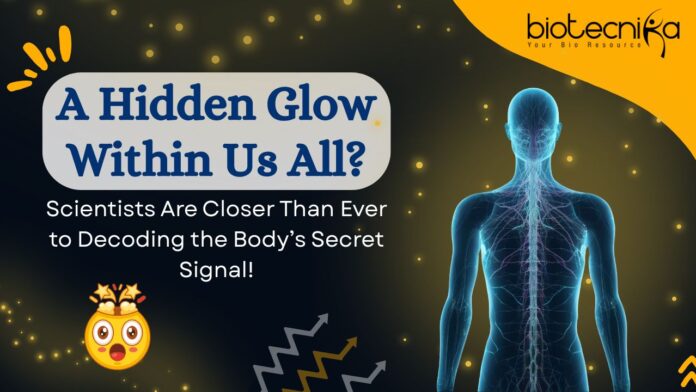Hidden Light Emitted by Every Living Organism
Imagine walking in a hospital where your body twinkles, visibly dim for a human’s eye, and could reveal your health status instantly. Imagine that your body was glowing, and it could reveal information about stress, your health, and even your last breath.
This futuristic vision is closer to our realities. In an extraordinary Scientific discovery at the University of Calgary, Researchers have confirmed that every living organism emits a faint light, known as UPE (Ultraweak Photon Emission). This discovery bridges modern Biochemistry with ancient Philosophy. This Research provides insights into our understanding of biological vitality and a new path for developing non-invasive Health Monitoring Technologies for humans.
The research was led by Dr. Daniel Oblak, a physicist. It provides Scientific evidence that UPE is directly correlated to oxidative stress and Cellular metabolism and vanishes at the time of death. This faint light emission is almost invisible to the human eye.
Do you know what this glow is, and how it can reveal vital information about our lifespan, consciousness, and health? Well, to understand this complexity, let’s take a closer look at the Science behind this light of life.
Ultraweak Photon Emission
UPE, or Ultraweak Photon Emission, is a natural and Biological phenomenon in which living organisms emit low levels of light, usually 10-1,000 photons per square centimeter per second. This brightness is 1,000-1,000,000 (approximately) times dimmer than the threshold of human vision.
As we’ve witnessed Bioluminescence in fireflies or even delayed luminescence in plants, UPE isn’t actually externally triggered for luminescence. It is a continuous, permanent, and spontaneous emission that is Biological and universal. As per the research, it is generated by Cellular and Biological processes and is present in all single-celled as well as multicelled organisms. It is a measurable biomarker intrinsically tied to life itself, but it disappears the moment metabolic processes cease.
This discovery has the potential to develop powerful diagnostic tools in the Healthcare, Food Safety, as well as Agriculture sectors.
The Science Behind the Glow
UPE originates from ROS (Reactive Oxygen Species), the molecules generated during oxidative stress and metabolic processes. When ROS interacts with Biological molecules such as lipids and proteins, it generates electronically excited states in the body. As these excited states return to lower energy levels, they release energy, eventually emitting photons. Scientists reveal that this photon emission results in a dim light, which can now be detected.
They further added that these UPEs are the ‘sensitive window’ into the living tissues’ oxidative processes. Its spectral patterns as well as intensity directly reflect a living organism’s metabolic state. This can be utilized as a potential real-time health indicator for the living.
The Experiment
To test this hypothesis that “UPE is a marker of life,” Dr. Oblak’s Research team conducted a few controlled experiments on laboratory mice. The results were quite unbelievable. The study reported that the living mice emitted significantly more photons than the dead mice, which showed nearly no emission. This difference confirmed that UPEs are an intrinsic feature of our metabolic activity and end immediately when the metabolic activity ceases.
They observed that in plants, when the organisms were exposed to chemical stress, temperature fluctuations, and mechanical damage, there was an increase in the UPEs. For example, a leaf’s damaged areas emitted a higher number of photons when compared to the healthy regions of the leaf, showcasing increased oxidative stress or ROS. Studies on leaves of Thale cress (Arabidopsis thaliana), Marsh Pennywort (Hydrocotyle vulgaris), and Maidenhair tree (Ginkgo biloba) revealed distinct UPE patterns correlated with specific stress levels.
Moreover, the photon emission in Sunflowers (Helianthus annuus) was tracked over time to monitor different Phenological stages (a plant’s developmental stages), demonstrating the potential for using UPEs to study a plant’s development non-invasively.
How Scientists Detect Life’s Glow
Capturing such faint light requires specialized and advanced tools and technologies. The Research team utilized EMCCD (Electron-Multiplying CCD) cameras, which could detect individual photons with a quantum efficiency of more than 90%. These advanced imaging tools allow Scientists and Researchers to visualize the temporal and spatial dynamics of UPEs in the living.
The Researchers designed an independent UPE imaging system that significantly outperforms other imaging methods in resolution and sensitivity. For spectral analysis in the experiment, they employed Bandpass Interference Filters to locate the emission’s exact wavelength ranges. This was instrumental in identifying plant stress responses. For example, in plants, the UPEs peak in the far-red or red spectrum (ranging from 700 to 750 nanometers). This wavelength range corresponds to the activity of singlet oxygen (a particular type of ROS) and is influenced by the plant’s internal detoxification systems.
This Scientific advancement has transformed UPE research from a mere curiosity to a practical experiment and a quantifiable metric for real-time biological assessment.
The Real-World Applications of Hidden Light Emitted by Every Living Organism
The implications of this Research are wide-ranging in the Healthcare, Food Industry, and Agriculture sectors. In Medicine, UPE could be a noninvasive Diagnostic Tool for detecting inflammation, cellular damage, and oxidative stress. It also holds potential in traditional Chinese Medicine Research, where concepts such as vital energy align intriguingly with the idea of a measurable “life glow.”
In the Agricultural sector, UPE could allow farmers and scientists to monitor crop stress as well as plant health without touching the plants. This method could significantly improve disease prevention, crop management, as well as yield forecasting.
In the food industry, UPE-based systems could assess food freshness and quality in perishable goods through reliable and non-contact imaging methods.
In Transplant Medicine, the ability to assess organ viability through UPE could one day become standard practice. Since the emission disappears immediately upon death, this method could provide a real-time, non-invasive way to evaluate tissue health before transplantation. In neuroscience, future studies could explore whether brain activity patterns emit distinctive UPE signals, potentially opening novel avenues in mental health diagnostics.
Although ethical guidelines still restrict human testing of UPE, the researchers suggest that “there’s no biological reason to believe humans would differ from other mammals regarding UPE.” This opens the door to a future where wearable devices or medical scanners could detect UPE as a health indicator.
Bridging Ancient Philosophy and Science
This Research also lends scientific weight to long-standing Philosophical and Spiritual ideas. For centuries, various cultures have spoken of an “energy field” or “life force” surrounding living beings. While the scientific community has largely dismissed such concepts, UPE provides a Biochemical basis for the idea that life emits light. UPE offers a measurable and Scientific basis for this long-debated “life glow.”
The researchers concluded that this scientific validation of life’s literal glow bridges modern Biochemistry with the ancient concepts of vital energy, offering unprecedented insights into fundamental Biological processes. And provided quantifiable evidence that life produces measurable light that disappears upon death.
Key Takeaways of the Hidden Light Emitted by Every Living Organism
- It stops instantly at death and can potentially be a life-detection tool.
- UPEs are a universal Biological phenomenon connected to oxidative stress and metabolism.
- This phenomenon resonates with ancient Philosophies of vital energy, and is now validated by Science.
- Emerging advanced Imaging Technologies are making UPE detection more accessible.
- Applications in Agriculture, Food Safety, Medicine, and beyond.
UPE’s future research is quite luminous and bright. As advanced Imaging Technologies, the field is poised to revolutionize Agriculture, Diagnostics, Biomedical research, as well as Food Safety. With further development, UPE monitoring may become as routine as checking vital signs, transforming how we diagnose and understand health. With increasingly sophisticated UPE imaging systems, we are entering a new frontier in diagnostics and biological research. Future innovations might let us track our inner light like a fitness tracker monitors steps.
By uncovering the subtle photon emission that accompanies life—and vanishes with death—scientists are not just detecting light; they’re illuminating the very essence of vitality.























